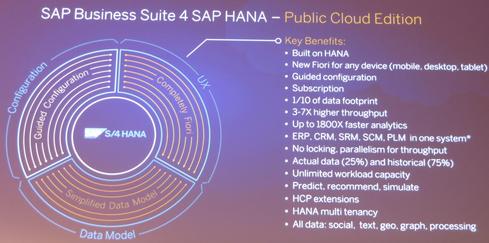SAP's Bernd Leukert looks ahead for smartwatches, the Internet of Things, and HANA to tie it all together.


10 Management Books Every CIO Should Read
10 Management Books Every CIO Should Read (Click image for larger view and slideshow.)
The Internet of Things (IoT), the importance of seamless integration between cloud and on-premises deployments, and responsive design for mobile devices are among the priorities defined by customers of SAP as they look to use the company's HANA platform to drive new business applications.
Bernd Leukert, executive board member responsible for products and innovation at SAP, told InformationWeek in a telephone interview that the company has signed contracts with companies looking to use HANA to develop IoT services. "We have taken companies live to enable new [IoT] business models," he said.
Earlier this year, the company announced SAP S/4HANA Public Cloud, a next-gen application suite. As with most SaaS apps, S/4HANA Public Cloud will be configurable, but customers who want to continue to use company-specific customizations or legacy interfaces might opt for private-cloud managed services.
When asked whether HANA, especially in the cloud, is a platform better suited for development than full-scale production, Leukert pushed back. "HANA as a platform is not just a development environment," he said, pointing out features of HANA that make complex applications easier to develop. "Geospatial capabilities and processing structured and unstructured data are things that our competition does not have," he said.
Leukert said he expects IoT to be a major driver of adoption for HANA, whether on-premises or in the cloud. "HANA and the HANA cloud platform allow you to build the new kind of business applications," Leukert said. "You need perfect integration [from the cloud] into [S/4HANA], and if you build a loosely coupled application there will be problems."
[ Is the enterprise ready for the IoT? Read IoT Revolution: Is The Enterprise Ready? ]
As an example, Leukert talked about a predictive maintenance application that pulls sensor data from equipment, which then goes into a process that creates work orders, assigns maintenance personnel, and ultimately confirms that work was done. In this sort of application, he said, there's no place for loose coupling.
With the discussion of loose and tight coupling, though, Leukert readily admitted that there are customers who depend on both on-premises and cloud versions of HANA. "S/4HANA and HANA [in the cloud] have different ecosystems and different customers, but the seamless integration between the on-premises and cloud is very, very essential," he said. "Even customers with a cloud strategy can't switch overnight from on-premise[s] to the cloud, so they will live for some quarters in a hybrid world."
Leukert said that one of the key points for the company is to allow its customers to make the transition between cloud and on-premises at the speed dictated by their business needs, rather than by any boundary conditions imposed by SAP. That's important, he maintained, not just for end-user customers, but aso for the partners delivering SAP-based applications to multiple customers. "With the HANA cloud platform, we will have an integration layer that allows us to deliver integration technology as well as content, and allows the customers to deliver solutions that are deployed, not just once on-premise[s] or in the cloud, but hundreds of times," he said.
Leukert emphasized that the experience on end-user devices -- particularly on a new range of mobile gadgets such as smartwatches -- is crucial to the success of any application. "You need a responsive design that allows you to run the application, not just on tablets or desktops, but on smartwatches," he said.
It's not that every application will be delivered on the smallest screens for every user, though. "It needs to make sense," he said. "It might not be a call-center person who takes the call on a smart watch." However, he emphasized that smart watches need to be considered in designing a simple interface.
In the SAP environment, for example, mobile can no longer be a minor check-box issue, Leukert said. "While mobile was a separate category in the past, today I'm only talking about a characteristic of the solution," he said. "Today, all SAP solutions have to run on mobile devices -- whether a phone, tablet, or smart watch depends on the actual use-case."
SAP released financial results for its first quarter on Tuesday, and the news leaned heavily on the cloud. In a briefing call with analysts and reporters, SAP CEO Bill McDermott highlighted a number of factors that contributed to SAP's positive news in the results:
Profit is up 15% year-over-year in spite of significant investments.
In Q1, cloud saw triple-digit growth at a 131%, and McDermott said SAP ended the quarter with about 80 million cloud users.
Software and cloud revenue grew 24% which McDermott said was SAP's fastest growth-rate in the last 12 quarters.
The company has more than 6,400 total HANA customers, according to McDermott, double the number from this period a year ago.
When asked about the contribution made to the quarter's financial results by HANA, both on-premises and in the cloud, Leukert said, "The numbers confirm that customers engage and acknowledge the strategy in a big way. They see the value they get out there."
The financial results come a couple of weeks ahead of SAP's annual user conference, Sapphire Now, which will take place in Orlando, Fla., May 5-7. SAP has traditionally used Sapphire Now to showcase successful customers and introduce new products and services, and this year's event seems unlikely to break that mold.
Interop Las Vegas, taking place April 27-May 1 at Mandalay Bay Resort, is the leading independent technology conference and expo series dedicated to providing technology professionals the unbiased information they need to thrive as new technologies transform the enterprise. IT Pros come to Interop to see the future of technology, the outlook for IT, and the possibilities of what it means to be in IT.
About the Author(s)
You May Also Like







